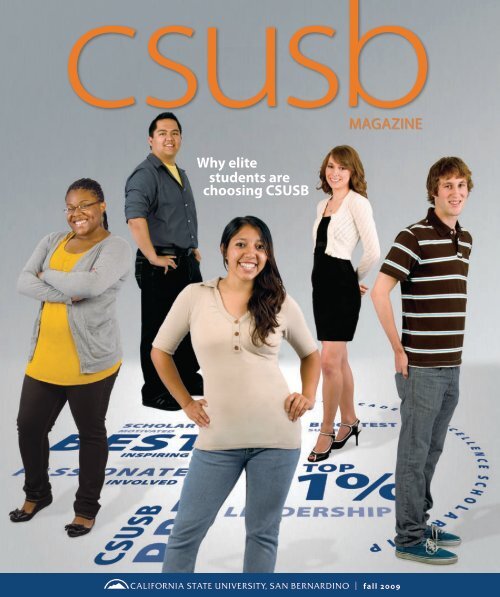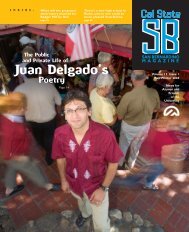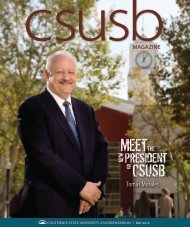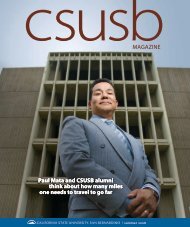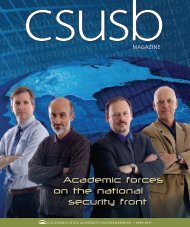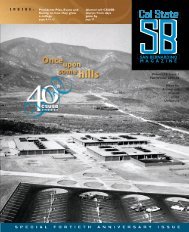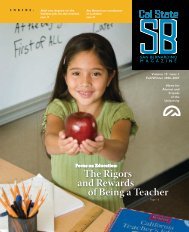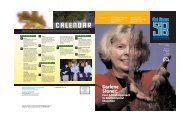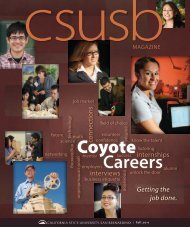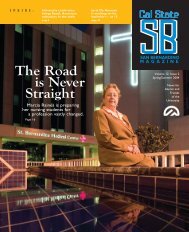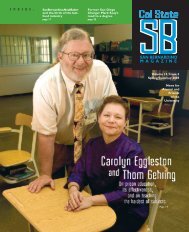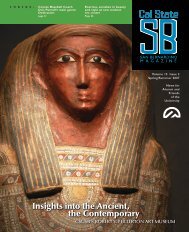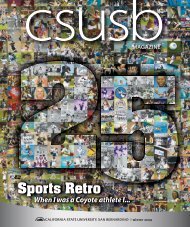Why elite students are choosing CSUSB - CSUSB Magazine ...
Why elite students are choosing CSUSB - CSUSB Magazine ...
Why elite students are choosing CSUSB - CSUSB Magazine ...
Create successful ePaper yourself
Turn your PDF publications into a flip-book with our unique Google optimized e-Paper software.
<strong>Why</strong> <strong>elite</strong><strong>students</strong> <strong>are</strong><strong>choosing</strong> <strong>CSUSB</strong>| fall 2009
Staying connectedis just a click away!Let the <strong>CSUSB</strong> Alumni Association help you reconnect with friendsand former classmates through our online community.Log on today and …• search for friends and former classmates in the enhanced alumnidirectory• use our expanded c<strong>are</strong>er connection to promote your businessand network with other <strong>CSUSB</strong> alumni (even post a résumé)• post your own class note and sh<strong>are</strong> what’s happening in your life(or just see what others <strong>are</strong> up to)• discover the newest benefits of Alumni Association membership!To access the site and register:1. Visit www.csusbalumni.com2. Click “Register Now” in the RegistrationLogin Box3. Enter your last name and alumni ID#found above your name on the mailing label4. Complete the registration form and you <strong>are</strong>on your way to enjoying the site!Y our privacy is important to us. This secure site is exclusively for<strong>CSUSB</strong> alumni and many of the pages <strong>are</strong> accessible only by usinga unique username and password. Only registered <strong>CSUSB</strong> alumnihave access to the password-protected <strong>are</strong>as where your contactinformation is listed.<strong>CSUSB</strong> <strong>Magazine</strong> is published by the Office of Public Affairsat California State University, San Bernardino foralumni, friends, p<strong>are</strong>nts, colleagues and the community.This publication is partially funded with non-state resources.Opinions expressed in <strong>CSUSB</strong> <strong>Magazine</strong> do notnecessarily reflect the views of the editors or representthe official policy of California State University, San Bernardino.The editorial committee reserves the right toedit all submitted material. Editorial and alumni informationand photographs should be sent to:Volume 18 Issue 1 — Fall 2009News for Alumni and Friends of the UniversityCal State San BernardinoPublic Affairs: Managing Editor5500 University ParkwaySan Bernardino, CA 92407-2318Photographs submitted for print consideration must beof good quality. Low resolution digital images below200k or photographs printed on textured paper <strong>are</strong> notaccepted.Alumni and Graduating StudentsPlease note that your name, address, phone number,school or college, and the year of graduation may beused by <strong>CSUSB</strong> for the development of university affiliatedmarketing programs. If you do not wish to have thisinformation used, please notify the university by writingto the Office of University Advancement at 5500 UniversityParkway, San Bernardino, CA 92407-2318.editorSid Robinsonmanaging editorSam Romeroart director/graphic design/illustrationJuliet Conlonproduction managerAlan Llavoresenior writersJiggs GallagherJoe Gutierrezdepartment editorsalumni advantagePamela LangfordcontributionsFrancoise AylmerMarilyn Karnigpack tracksMike Murphystudent scapesCarol Dixoncontributing writersTerri CarlosDerek GallowayCarmen Murillo-MoyedaCindi PringlephotographyRobert WhiteheadLori KruegerinternsEmilee FellerAshley JonesLigaya MalonesAndrew VillarrealBrittan Westgraphic design assistantTheo DeHart
EXPR ESCHOLAR SCHOLARMOTIVATED MOTIVATEDBESTINSPIRINGASSIONATES IDPRESIDENT’SE NP R<strong>CSUSB</strong>T ’E SI DPRESIDENT’SE NBRIGHTEST BRIGHTESTSUCCESS SUCCESSEDUCATIONT ’SINVOLVEDLEADERSHIPI PTOP TOP1%<strong>CSUSB</strong>SINVOLVEDEDUCATIONS HA CA RAPDH IEO LMSI CA RAC HCELAX CSODE LL EEC ES CHMIN CECE NCEL LFound wisdom(page 3)Departments2 President’s ObservationsAll good things must come to an end, includingthe tenures of two influential administrators.3 UpdateRecessions, depressions, college class sessions –energy is never in short supply when John Husing istalking economics. (page 4)7 College NewsA <strong>CSUSB</strong> psych professor earns award forhaving the creative mind to effectively researchthe creative mind. (page 7)<strong>CSUSB</strong> President’s Academic Excellence Scholarship <strong>students</strong>(from left to right) Russell Coronel, Beatriz Crisostomo, RachelWolfinbarger, Bryan Bennett, and Nkechiyere Eboka.Page 10F e a t u r e s3 UpdateThe last founding professor of <strong>CSUSB</strong>believes that after more than 40 yearsof instructing, he has been the one tolearn more.14 ContributionsThe new observatory on campus willbe named after a family that used topick grapes on the university grounds,before there even was a <strong>CSUSB</strong>.How much they gave(page 15)Good job hunting(page 21)14 ContributionsFanf<strong>are</strong> for an uncommon woman – Evelyn Magnuson.(page 15)17 Pack TracksClose, but no dice. Coyotes come up just shortin their quest to win an NCAA Division II golfchampionship. (page18)21 Student ScapesStudent jazz guitarist will realize dream of seeing“King” of blues in concert – by helping open the showfor the legend. (page 22)25 Alumni NotesWhat’s up with your former classmates?CalendarSee, see B.B. (back cover)17 Pack TracksOn its 25th anniversary and during itsinaugural Hall of Fame ceremony, theathletics department inducts five of itsgreatest heroes.21 Student ScapesIn these tough economic times, acounty administrator and <strong>CSUSB</strong>alumnus is attempting to help othersprosper by “growing people.”Editor’s noteThe Web – with a slight assist of late from the shaky California state budget – haschanged publishing forever. For years, Cal State San Bernardino has supplied editionsof its alumni magazine that readers can actually hold in their hands. While <strong>CSUSB</strong> willcontinue to produce the magazine, with this issue we <strong>are</strong> shifting to a once-a-yearprinted piece (rather than twice-a-year) and will establish a fresh and stronger onlinepresence. This new “Webzine” will continue to keep you up-to-date on what’s happeningat <strong>CSUSB</strong>, but also will offer greater flexibility in how we stay connected to you. We’lllaunch our new Internet edition in the next few months and will let you know by mailwhen we’re up and running. Web publishing is here to stay, and whether we come to youby paper or by pixel, we <strong>are</strong>, too.fall 2009
president’s observationsAll good thingsTwo expressions nicely describe recentdevelopments at Cal State San Bernardino:“All good things must come to an end”and “The best journeys start with goodfirst steps.”The truth of both expressions can beseen in recent changes among senior administratorsat <strong>CSUSB</strong>. I believe Lou Fernandezand David DeMauro each havebeen as good in their roles as any universityprovost or business vice presidentin the nation. More importantly, they’vebeen, as a tandem, even better than theywould have been individually.Dr. Fernandez, our longtime vice presidentfor academic affairs and provost ofthe university, has served as the chief academicofficer since 1994. As the personwho sets the tone for academic life, Loucreated an environment where academicexcellence excels and is rewarded. He hasall the skills needed for success – budgeting,curriculum, personnel management,recruitment, academic planning and thelike. Perhaps even more importantly, he’smaintained the highest standards whileencouraging a collegial environment focusedon student development and facultyachievement as teachers, scholarsand public servants.Lou presided over great enrollmentgrowth, improvement in retention andgraduation rates, creation of our initialengineering, M.F.A. and doctoral programs,as well as expanded scholarly activity,including significant increases ingrants and contracts.His commitment to teaching and learningled early in his tenure to developmentof the now highly regarded TeachingResource Center, which promotesfaculty instructional excellence. He wasalso instrumental in developing the RobertV. Fullerton Art Museum, now one ofonly 4 percent of accredited museums inthe nation. His strong commitment wascritical in advancing <strong>CSUSB</strong>’s Palm DesertCampus. And Lou also helped to createvarious meaningful centers and institutes,including the Inland Empire Centerfor Entrepreneurship, the Water ResourcesInstitute, the University TransportationCenter and the International Institute.While his intelligence and spirit will bemissed, his influence will have a lastingimpact on the university’s future.In Lou’s place, we’re pleased to welcomeAndrew Bodman, who comes to San Bernardinofrom Western Washington Universityin Bellingham, Wash., where heserved as provost and VP for AcademicAffairs. Before working at Western Washington,Dr. Bodman spent 21 years at theUniversity of Vermont, where he was afaculty member, department chair, viceprovost and interim dean of the graduatecollege.Andy has brought an exceptional recordof program, student and personneldevelopment. Our faculty have welcomedhim enthusiastically, and we’redelighted that he joined us in mid-July.Given his experience and successes elsewhere,we believe that he’s poised to helplead <strong>CSUSB</strong> to important new academicachievements.The second key administrator, DavidDeMauro, retired recently. He served asvice president for administration and financesince 1990. (David was only thesecond person to hold that post.) Hecame to <strong>CSUSB</strong> in 1986 from the constructionindustry to serve as the directorof the physical plant. In that role andas vice president, he’s provided innovativedirection in planning, financing andbuilding 22 major capital projects andseven large-scale renovations on thiscampus, as well as land acquisition andconstruction of four major buildings atour Palm Desert Campus.In all, campus facility size more thandoubled under David’s excellent leadership.And his administrative responsibilitiesextended not only to planning andconstruction, but also to our financial services,facility and grounds maintenance,police, the Foundation, purchasing, humanresources and award-winning customerservice. He played a key role increating the first-ever CSU public-privatestudent housing project, as well as in negotiatingother development arrangements,including the CSU system’s firstpublic-private housing partnership.David’s legacy ranges from greatly enhanceduniversity-wide quality improvementprograms to dramatically expandedphysical facilities, to a trail-blazing recordof energy efficiency and environmentalfriendliness, to policies and practices thathave consistently lifted the institutionand earned national recognition, includingthe American Association of PhysicalPlant Administrators 2007 Award for Excellencein Facilities Management – thehighest award possible.David’s successor is Robert W. Gardner,a highly accomplished federal governmentadministrator, who came to <strong>CSUSB</strong>from the National Aeronautics and SpaceAdministration, where he was chief financialofficer at the Dryden Flight ResearchCenter at Edwards Air Force Base. Previously,when serving as chief financial officerat the Transportation Security Administration,he was responsible for its nearly$6 billion budget.Bob is a native Californian with rootsin the Inland Empire. He’s brought outstandingadministrative ability to thecampus. Since the university will experienceserious budget challenges over thenext few years, we’ll benefit greatly fromhis financial and budgeting skills.So good things have in fact come to anend, while we’re fortunate to have takengood initial steps on the next stage of theuniversity’s journey.2 | fall 2009
update on cal stateGolden ErasBy Brittan WestThe measure of an educator doesn’t rest in the pails he hasfilled with liters of knowledge, but rather the fires of academiahe has sparked in his <strong>students</strong>. Bruce Golden hasbeen starting such fires since 1965, when he first arrived at CalState San Bernardino. Earlier this year, hecarried the torch out as the last of <strong>CSUSB</strong>’sfounding faculty members to leave.At about 30 members in 1967, the facultynumbers were slim, and so were theuniversity’s class catalogs, which were, infact, thinner than the class schedule itself.The English Department for whichGolden taught was sequestered on campusin what is now the AdministrationBuilding.These early days saw faculty and <strong>students</strong> playing basketballand touch football on land that is today the site of the Commons.However, says Golden, “We learned not to play with the <strong>students</strong>.It was a little intimidating to look down the line of scrimmageand see this guy who was in your class who may not have agreedwith the [grade] on his paper. So you didn’t want to get deckedby someone who outweighed you by 50 pounds.”The spring of that first school year also saw a softball leagueemerge, and faculty and <strong>students</strong> may have played that together,too. But at over six feet tall, Golden played basketball and wasPhotos by Lori Krueger and Robert Whiteheadever wary of “any errant [student] elbows.”Since then, Golden has seen the campus undergo vigorouschange, particularly in the widening of its student diversity. “Peoplewere coming from Rialto, San Bernardino, maybe Riverside.And now we have the Palm Desert Campus, people coming infrom Victorville, Hesperia. If anything, the quality has gotten better.We’ve got a lot more <strong>students</strong> going to graduate school, professionalschool, and [going for] advanced degrees.”Golden believes that he has stayed much the same, saying, “Idon’t think I’m any smarter. But I’ve learned more.” Admittedly, hehas learned more patience in the classroom. “In the early days Iwas conscious about filling dead space. I think now I can sit andwait.” The act of teaching changes teaching, says Golden. Thepassage of time changes class size in the same way. “Our classes<strong>are</strong> slightly bigger. We had years when most classes were 20or less and now we have classes that go up to 20, 28 and 45. Sowhen you think about the old days, you think about the reallysmall classes.” Yet smaller classes did not necessarily mean better,because, as Golden points out, you “need a critical mass to stir adiscussion and we get that now.” To stir and bring discussions toa boil, Golden employed subjects ranging from rock and roll, torhetoric, literary theory, Shakespe<strong>are</strong> and even Woody Allen.But teaching classics hasn’t kept him from learning thecontemporary. Students have been a technological lighthousefor Golden. “In the past I had no idea about computers. How<strong>students</strong> read my handwriting I don’t know.” He successfullynavigated these digital straits with the help of a past graduatestudent. There were times when they needed to talk about aseminar or her thesis away from campus. “She lived in Wildomarand I lived in Lake Arrowhead. So she showed me how we couldcommunicate through ICQ [literally ‘I seek you’], the predecessorto instant messaging. Through her I learned how to comment on<strong>students</strong>’ papers online.” He learned a lot by listening, he says.During his time, a man takes on many roles, and Woody Allenhimself said that 80 percent of the success in playing differentroles is just showing up. Golden has risen to each occasion.Along with the other founding faculty members of the university,he has left embers of wisdom and knowledge that will burnlong into Cal State San Bernardino’s future. ●Brittan West is a 2009 graduate of <strong>CSUSB</strong> with a bachelor’s in communication.She served as an intern in the university’s Office of Public Affairsduring the winter 2009 quarter.csusb magazine | 3
update on cal stateEconomic enginesIn the late 1970s, John Husingwaltzed into the economics classhe was teaching at San BernardinoValley College sporting a handheavily wrapped in bandages. Ordinarily,the sight wouldn’t havestirred any more interest than theusual, casual inquiry. Except thathe mentioned, somewhat embarrassed,that it all happenedwhile he was teaching. How aneconomics instructor injures ahand while teaching (in Husing’scase, an animated sweeping motionwith the arm and smashinghis knuckles against the metalrailing of a chalkboard) is, well, amarvel. Then again, this is vintageJohn Husing.Named <strong>CSUSB</strong>’s ArrowheadDistinguished Executive Officerof 2009, Husing has probed theDegrees ofexperienceIn college, bachelor and master’s degreestypically go to theyoung and <strong>are</strong> groundedentirely in what you know.But the rules <strong>are</strong> differentwith honorary degrees.These typically come laterin life, and they <strong>are</strong> given asmuch for what one does forthe world as for how muchhe or she knows about it.For Nicholas Coussoulisand Ernest Siva, what theyknow of the world is that itisn’t moved by spectators.Albert Karnig, Cal StateSan Bernardino president,summed up that notion and the menlike this: “These two men, in differentways, have improved the lives of manythousands of people in our communities.”For example, said Karnig, “NickCoussoulis has provided housing, commercialspace and employment to countlesspeople in our region. Ernie Siva hasenriched both the Native American andthe larger community by being centralto the transmission of Indian culture andthrough his exceptional work as a musician.”So this past June, Coussoulis, chairmanof Coussoulis Development in SanBernardino, and Ernest Siva, respectedNicholas Coussoulis (left) and Ernest Siva (right)elder of the Morongo Band of MissionIndians, were awarded honorary doctoratedegrees during commencement exercises.For more than 40 years, Coussoulis’company has been in the land developmentand brokerage business. He hasbeen a leader in creating planned communitiesthroughout the Inland Empire.A long-time supporter of <strong>CSUSB</strong>, Coussouliswas the founding donor in thecampaign for a new <strong>are</strong>na at the universityin the 1990s. He made the lead gift,with one major request: he asked that the<strong>are</strong>na be named in honor of his p<strong>are</strong>nts,James and AerianthiCoussoulis. During the<strong>are</strong>na’s dedication ceremoniesin 1995, NickCoussoulis said, “Thegreatest achievementa son can attain is tohave the opportunityto publicly honor hismother and father.Their faith in one anothergave them thefortitude to raise theirchildren with dignity,respect for authorityand the determinationto achieve an education.”A <strong>CSUSB</strong> alumnus, having earned aB.A. in geography in 1975, Coussoulis is4 | fall 2009
Southern California economy for decades,and he’s done it with all the vimr<strong>are</strong>ly found in his profession, a professionknown for a staid and stolid posturethat is the economist’s stock-intrade.Greenspan and Bernanke haveit down cold, and cold receptions <strong>are</strong>what customarily meet any departuresfrom the mold. Husing admitshe is “flamboyant.” It’s a style forgedas a teacher, he says. Call it a flair fordecoding the macros and micros, themysterious language of surplusesand deficits, supply and demand, themarket. Listed in 2006 by Los AngelesTimes <strong>Magazine</strong> as one of the 100most powerful people shaping life inSouthern California, Husing has beena leading authority on the impactof the goods movement industry inSan Bernardino and Riverside countiesand the industry’s role in creatingjobs and income for blue-collar workers.About Husing, K<strong>are</strong>n Dill Bowerman,dean of <strong>CSUSB</strong>’s College of Businessand Public Administration, saidher college’s and Husing’s c<strong>are</strong>er missions<strong>are</strong> mirror images. “Our purposeis not to tell people what they want tohear. It is to explain what is researchedand analyzed to face reality that willbenefit the Inland Empire.” ●also a past winner of the Arrowhead DistinguishedExecutive Officer award givenby the university’s College of Business andPublic Administration.Siva has made it his life’s mission topreserve and pass on to future generationsthe cultures of Southern CaliforniaAmerican Indians. He has served as distinguishedguest artist in Native Americanculture at <strong>CSUSB</strong>. One of the last remainingspeakers of the Serrano language, Sivahas served as tribal historian and culturaladviser for the Morongo Band of MissionIndians since 1996. He also serves on theboard of directors of the California IndianStorytelling Association, the board oftrustees of Idyllwild Arts and the board ofthe Riverside Arts Council.Siva holds both a B.A. in music educationand an M.A. in choral music fromthe University of Southern California. Hetaught classes in American Indian musicat UCLA and has worked as a choir directorin several Southern California cities. Heespecially values his long history of teachingand performing Indian “bird songs,”part of the sacred experience of NativeAmericans. ●Calculatingthe value of 1In the 1988 film “Stand and Deliver,” Jaime Escalante,played by Edward James Olmos, said to his classroom ofunderachievers, “You burros have math in your blood.” He was explaining tohis Garfield High <strong>students</strong> that the people who first pondered the absence ofvalue – the zero – were the Mayans, who were their ancestors. His <strong>students</strong>went on to pass the difficult A.P. calculus test in unparalleled numbers.Who knows if math is really in every Hispanic’s blood? But it’s now official:Cal State San Bernardino is No. 1 in the United States among universitiesawarding bachelor’s degrees in math to Hispanic <strong>students</strong>, according tothe magazine Hispanic Outlook in Higher Education. The magazine’s list isderived from the U.S. Department of Education’s Integrated PostsecondaryEducation Data System program.Overall, the magazine – noted for its rankings – lists <strong>CSUSB</strong> as 12th in thenation in awarding bachelor’s degrees to Hispanics and 20th in awardingmaster’s degrees, as reported in its May 4, 2009 issue. The magazine also listedCal State San Bernardino as seventh in awarding bachelor’s degrees inprotective services to Hispanic <strong>students</strong>.Between July 1, 2007, and June 30, 2008, <strong>CSUSB</strong> awarded 1,154 bachelor’sdegrees and 237 master’s degrees to Hispanics.“Most of our <strong>students</strong> <strong>are</strong> the first in their families to attend college, andso it’s especially gratifying to see that they’re successful when they get here,”said university President Albert Karnig. ●csusb magazine | 5
ScienceHe grabbed some headlinesin interviews with CNN,the BBC and The New YorkTimes a few years ago when thesubject was death. A psychologyprofessor at Cal State San Bernardinosince 2002, his research had shownthat poets tended to die younger thanplaywrights, novelists and non-fictionwriters, and studies he’d pulled togetherfrom throughout the world proved it.But James Kaufman’s sojourns intomen’s heads have not beenfor that singular, morbid interestin uncovering whatblunt force brings an endto writers. No, what JamesKaufman really wants toknow is what makes the creativemind run.He has done it so effectivelyof late that the internationallyrecognized expertin creativity was given the2008 E. Paul Torrance Awardfrom the National Associationof Gifted Children at theassociation’s national conference.It was his advancementof creativity – particularlyamong gifted children– that impressed the associationmost.The award is named afterthe man dubbed the “fatherCues from thecreative mindof creativity,” E. Paul Torrance,and goes to contributionsof substancein the study of creativityand how it works.To earn the honor, awardees <strong>are</strong> themselvessupposed to be creative thinkers,usually prolific writers and perhapspopular speakers. Kaufman fits the rule.The author of several books and articles,he has been a keynote speaker at majorinternational creativity conferences,James Kaufman’s research in creativity has spanned more than 10 years.college newsincluding keynote addresses and guestlectures in Spain, Sweden and Taiwan.His studies have been widely cited. Andhe was recently tapped to edit a newjournal on international creativity andproblem solving.Kaufman is an active member of theNational Association of Gifted Childrenand the American Psychological Association,among other affiliations, and isthe director of the Learning Research Instituteat Cal State San Bernardino. ●csusb magazine | 7
college newsJust what the doctor orderedThe times they <strong>are</strong> a changin’. Minority<strong>students</strong> with Ph.D.s in scientific disciplinesmay no longer be such a minority.Thanks to a $1.5 million grant from theNational Institutes of Health, Cal StateSan Bernardino will help more minority<strong>students</strong> pursue doctorate degrees andbecome researchers in the fields of biology,chemistry, kinesiology, physics andpsychology.Historically, only a small number of<strong>students</strong> from underrepresented minoritygroups have pursued Ph.D.s in thesescience fields. But the five-year grant inthe amount of $1,546,866 seeks to nearlydouble the number of minority <strong>students</strong>in doctorate school. The NationalInstitutes of Health plans on doingthis by encouraging more minority undergraduatesto enter the Minority Accessto Research C<strong>are</strong>ers program. Oncethere, NIH wants to prep<strong>are</strong> them forthe rigorous study involved in securinga doctorate degree.“The future of the nation’s biomedicalresearch workforce depends on the continueddevelopment of well-trained undergraduateswho seek biomedical andbehavioral doctorates,” said <strong>CSUSB</strong> psychologyprofessor Sanders McDougall,who is the grant’s principal investigator.“The next generation of researchers willbe made up increasingly of underrepresentedminorities who historically havenot pursued doctorates. Our projectseeks to attract and prep<strong>are</strong> Cal StateSan Bernardino <strong>students</strong> to meet thisnational need.”Participants in the program will haveabout 70 percent of their tuition paid for,receive a monthly stipend while workingat an NIH-funded laboratory at Cal StateSan Bernardino, receive travel expensesto attend scientific conferences, and receivesummer placements with internationallyknown researchers at top-tierdoctoral programs. Perhaps the mostimportant program feature is that theywill receive funding to take the GraduateRecord Examination, which is an admissionrequirement for many graduateschools and, in essence, the first big stepin getting the ball rolling toward completinga Ph.D. ●BusinessAccounting forthe massesThe <strong>students</strong> that jam the B.S. in accounting program at Cal State San Bernardinoknow all about the power of numbers. At 700 strong, they have made the degree thelargest undergraduate program in the university’s College of Business and Public Administration,and the degree’s popularity has set the table for the new master’s in accountingprogram now underway.“We expect this program to attract at least 30 to 40 <strong>students</strong> in the first cohort,” saidGhulam Sarwar, chair of the accounting and finance department. “As we get more interest,we may expand access in coming years.”The master’s degree fulfills new requirements set by the state of California for thosetaking the certified public accountancy exam. Educators expect these new standardsto take effect in 2010 or 2011; several other states have already implemented them.The master’s degree is also useful for accountants who want to rise in managementwithin their organizations.Students in the department’s undergraduate program, Sarwar added, have the optionto sign up for the “3-plus-2” program, where they can receive both the bachelor’sand master’s degrees in five academic years. Those with degrees from other universitieswho need to fulfill prerequisites can get the master’s degree in one-and-a-half totwo years. ●8 | fall 2009
Campus or community memberscan receive counseling for…Relationship issuesP<strong>are</strong>nting problemsLife chanagesPersonal growthDepressionAnxietyCommunityCounselingCenter@CsusBQualityCounselingyou CanaffordFor more information,call (909) 537-5569How many counseling servicestoday offer quality, confidentialc<strong>are</strong> at a price you can afford? Atleast one. Cal State San Bernardino’sCommunity Counseling Center isstaffed by graduate <strong>students</strong> inpsychology and supervisedby university facultywho <strong>are</strong> licensedpsychologists.Counselingservices <strong>are</strong>provided for $15,which is waivedwheneverneeded.EducationRenewed accreditation,new recruitsTrying to decide what college to attendto pursue your dream of earning aneducation degree? In that case, nationaland state accrediting bodies have reinforcedthe view that the College of Educationat Cal State San Bernardino wouldbe an excellent choice.The National Council for the Accreditationof Teacher Education and the CaliforniaCommission on Teacher Credentialingvisited the university’s educationcollege this past spring, and after twodays of rigorous examination and interviewswith more than 1,000 administrators,program directors, teachers, K-12colleagues, <strong>CSUSB</strong> alumni and current<strong>students</strong>, the review teams recommendedthe school for full continuing accreditation.In fact, Patricia Arlin, dean of COE,said that the two teams finished much oftheir work sooner than expected.The university’s educator programsinclude service learning, where liberalstudies majors spend 120 hours in elementaryand middle school classroomsobserving and working with veteranCollege of Education Buildingteachers. All of <strong>CSUSB</strong>’s teacher prepprograms offer full- and part-time options,and all include an intern route,where <strong>students</strong> can work as employedintern teachers while they completetheir studies.Besides reviewing the basic teacherprograms, the two teams evaluated theuniversity’s licensure programs. Thoseincluded curriculums for school administrators,nurses and counselors and psychologists,reading specialists, adaptiveP.E. teachers and c<strong>are</strong>er and technicalteachers. The state review team’s recommendationwas adopted by the CCTCin June, and the national team’s recommendationwill be studied in October.If the NCATE board accepts the recommendations,the national accreditationwould last for seven years – the sameperiod approved by the CCTC. The approvalsbolster the College of Education’seducator recruitment efforts, saidIris Riggs, associate dean of teacher educationat <strong>CSUSB</strong>. ●csusb magazine | 9
motivated n passionate n top 1% n leadership n success n pride in work n best n inspiring n involved n brightest n <strong>CSUSB</strong>A prestigious scholarshipis bringing some of theInland Empire’s besthigh school <strong>students</strong>to <strong>CSUSB</strong>, and raisingthe academic gameof their classmates.Shooting for the moonBy Sid Robinsonand Sam RomeroNkechiyere Eboka couldn’tmake up her mind.The Arroyo Valley HighSchool senior had been acceptedat the University ofCalifornia, Berkeley, UC Irvine,UC Davis and several CaliforniaState University campuses,including Cal State SanBernardino.“It was a difficult decision,and I could have gone to anynumber of prestigious schools,but it came down to decidingbetween (<strong>CSUSB</strong>) and Berkeley,”says Eboka. “I felt I couldget the same education hereas at Berkeley. But I was ableto stay close to home, I’m gettinga good education and I’mnot paying as much becauseof my scholarship.”The “scholarship” is the President’sAcademic ExcellenceScholarship, an annual $5,000sum offered only to San BernardinoCounty high schoolseniors who rank in the top1 percent of their graduatingclass and, of course, onlyif they choose to attend CalState San Bernardino.The program was born in2002, when <strong>CSUSB</strong> PresidentAlbert Karnig first extendedthe offer to “reach a selectgroup of <strong>students</strong> to raise thelevel of academic achievementon our campus and alsoadvance a leadership groupthat we hope will stay in the InlandEmpire after graduation.”10 | fall 2009
That first year, six <strong>students</strong> acceptedthe scholarship. Fifteenmore freshmen camethe next year, and the programquickly spiraled higher.By fall of 2008, the number ofincoming freshmen reached46, accounting for nearly 20percent of the San BernardinoCounty high school seniorswho qualified for the award.They joined some 100 otherPresident’s Scholars on campuswho were enrolled fromprevious years.“I never assumed,” Karnigsays, “that the program wouldlaunch as quickly as it has, andI never anticipated that we’dso soon have roughly 150 ofthe top 1 percent scholars onour campus simultaneously,accounting for nearly 1 percentof our entire undergraduateenrollment.”M o r e s u r p r i s e d t h a nKarnig about the rapid risein PAES <strong>students</strong>, perhaps,was a young A.B. Miller High“I felt I could get the same education here as at Berkeley.But I was able to stay close to home, I’m getting a good educationand I’m not paying as much because of my scholarship.”— Nkechiyere EbokaSchool senior, who learnedthat a $5,000-a-year scholarshipawaited her if she chose<strong>CSUSB</strong>. Rachel Wolfinbarger,who had alreadyconcludedthat theFashion Instituteof Designand Merchandisingin LosAngeles wasfar too steep afinancial climbat $100,000 toearn a bachelor’s,was indisbelief. Shewas still moreamazed whenshe learnedthat the fullride scholarshipincludedenough extramoney to helppay for books.“ I t d i d n’ tseem real,”says Wolfinbarger,whois now a senior business majorat <strong>CSUSB</strong>. While the newsalso stunned her mother, itcouldn’t have been more welcome.“We’re not poor. We’renot wealthy. We’re middleclass,” says Wolfinbarger.“Pick and save” had beenthe plan. Pick a communitycollege and save, save, saveto afford transferring to afour-year university. But thePAES money changed everything,and maybe its arrivalshouldn’t have surprisedWolfinbarger and her family.Her mother tells the storythat when Rachel was 10, shetold her mother that somedayshe would get a scholarship.Her mother laughed andsaid, “O.K., honey,” and leftit at that.PAES <strong>students</strong> have to maintaina 3.5 GPA or higher to receivethe scholarship for fouryears — a potential $20,000.With close to 150 President’sScholars on campus today —each receiving $5,000 — thechallenge is not so much ingetting these high performing<strong>students</strong> to Cal State SanBernardino, but in raisingthe nearly $750,000 it takesto cover the scholarshipseach year. The program isfunded solely through philanthropicsupport.“A prestigious programlike PAES isn’t one that youordinarily think of as needingthese private funds,” saysFrancoise Aylmer, associatevice president for developmentat <strong>CSUSB</strong>. “Prospectivedonors certainly want to helpNkechiyere Eboka has worked as a volunteer at St.Bernardine Medical Center in San Bernardino.(Photo by Lori Krueger)csusb magazine | 11
In Paris this past summer, Rachel Wolfinbarger – standing here before the Louvre – explored her interest inphotography during a month-long course of study.<strong>students</strong> financially. But theybelieve that these gifted <strong>students</strong>can get a ‘free ride’ anywhere,so they might overlooka program like PAES. The truthis, smart <strong>students</strong> need money,too, and the Inland Empireneeds these <strong>students</strong>.“The scholarship keeps thatbrain power here even aftergraduation,” Aylmer says.“The prospect of receiving aPAES scholarship is an incentivefor high school <strong>students</strong>to earn top marks in schooland guarantee a spot in avery competitive program.”Dr. Prem Reddy believesit. A noted cardiologist andthe founder and chairman ofthe board of Prime Healthc<strong>are</strong>Services, a Southern Californiahospital management company,Reddy is one of the largestPAES donors to date. “These<strong>students</strong> <strong>are</strong> the ones whowill lift others to success,” hesays. “When you meet these<strong>students</strong>, they make you veryproud. And that makes youwant to give more and more.”Despite the challenges toraise PAES money as the programgrows, Karnig says theinvestment for the universityand for donors is key for theentire region, because it givesthese <strong>students</strong> a powerful reasonto stay local. “College <strong>students</strong><strong>are</strong> more likely to settlein the <strong>are</strong>a where they go toschool, and so the goal is tokeep them here to somedaybe among the entrepreneursand the social, cultural, politicaland business leadersof our local communities.”Since the program began,virtually all PAES recipientshave either graduated or <strong>are</strong>still pursuing a <strong>CSUSB</strong> degree.Audra Wise becamethe program’s first graduatein 2005, finishing her B.S. inbiochemistry in just threeyears. She recently completedmedical school at LomaLinda University and is headingoff to San Francisco forher residency. Erica Thomasalso earned her bachelor’s inpsychology in three years,and used the fourth year ofthe scholarship for her firstyear of graduate school at<strong>CSUSB</strong>. Her master’s degreecomplete, she’s now teachingat Cajon High School inSan Bernardino.For the <strong>students</strong>, havingtheir education paid for is onlypart of the equation. In manycases, it’s also the opportunityto stay close to home.The scholarship, proximityand a good dose of beauty— it all made good sense toJoshua Gutierrez, a BarstowHigh student who had beenlooking into other universities“These <strong>students</strong> <strong>are</strong> the ones who will lift others to success.When you meet these <strong>students</strong>, they make you very proud.”— Prem Reddyfour years ago before hearingabout PAES. He’d nevereven set foot on the <strong>CSUSB</strong>campus. But once he learned12 | fall 2009
of the scholarship, he andhis p<strong>are</strong>nts took a drive southon I-15.“ I l oved t h e c a m p u s. Ithought it was beautiful,” hesays. “The only doubt I hadwas that I’d always expectedto go far away from home. Butthen, once I really consideredit, I thought, ‘I’ll be an houraway from home. I’ll still beaway, but I’ll still be home.’” Betweenthe ideal location andthe monumental influencehis p<strong>are</strong>nts had in encouragingschooling, the PAES offerproved irresistible. He graduatedfrom <strong>CSUSB</strong> in June withhis bachelor’s in English literature— the first in his family toearn a four-year degree. Nowhe’s working with Teach forAmerica, a national programaimed at taking the country’smost promising recent graduatesand having them teachin the communities that needit most.The chance to go to someof the most <strong>elite</strong> universitiesin the nation, such as Eboka’schance to attend Berkeley,<strong>are</strong> common options among<strong>CSUSB</strong>’s top 1 percent <strong>students</strong>.Staying near home wasEboka’s lure. “I like San Bernardinoand hope to workhere some day,” she says, havingalso been influenced byher sister’s experience with<strong>CSUSB</strong>’s nursing program. Butthe question still had to beanswered. Would she get asgood an education?inspiring n involved n brightest n <strong>CSUSB</strong> n motivated n best n passionate n president’s academic excellence scholarshipEboka thought so. Sodid Wolfinbarger. She rejectsthe perception that <strong>students</strong>can only get the most thoroughcurriculums at expensive,high-profile institutions.She felt fortunate, she says, toget a better price for the sameeducation.Broken down, that “sameeducation” comes in two partsfor Joshua Gutierrez — smallerclass sizes, good professors.As an English major, Gutierrezsays, “Hands down, in eachclass there’s a maximum of 20-25 people. But in my favoriteclasses, there <strong>are</strong> 10-15 people.And you’ll pretty much beone-on-one with a renownedauthor or someone just aswell-versed in their field.”Eboka believes she’s “learningmore here, because theclasses <strong>are</strong> smaller and I cantalk with my teachers insteadof having classes with hundredsof <strong>students</strong>.”Whether the classes <strong>are</strong>large or small, PAES <strong>students</strong>bring an enriched brand of intellectualsynergy to the classroom.“The PAES scholars <strong>are</strong>the proverbial tide that liftsall boats,” Karnig says, notingthat the scholars take greaterclass loads, achieve moreand inspire fellow <strong>students</strong> todo better in school. “They <strong>are</strong>highly motivated and very intelligent,and they set highmarks for others.”While PAES <strong>students</strong> feeladded pressure to do well andmaintain that 3.5 grade pointaverage, it’s often a pressurethey administer themselves.They don’t much c<strong>are</strong> for anythingless than A’s or maybethe occasional B. “I’m just acompetitive person,” Wolfinbargersays, “more with myselfthan with other people.” Andwhen she ran all A’s her firstyear of high school, her fathersaid, “You could be valedictorian.”She hadn’t looked ather grades that way. But fromthat moment on she made ita goal.It was not a goal shereached. Still, she finishedthird or fourth in her class,easily landing her in the top1 percent. “It’s kind of like thatquote, ‘If you shoot for themoon and if you don’t makeit, at least you’ll fall among thestars.’ I kind of feel like that’swhat I did in high school.”It’s what she’s doing in college,too. It’s what all PAES<strong>students</strong> do in college. Shootfor the moon. ●Joshua Gutierrez describes thefive-week program for Teachfor America as “teacher bootcamp.” Training at JergensenElementary School in Phoenixthis past summer, his day beganwith a 6:30 a.m. bus to work andended about 1 the next morning.csusb magazine | 13
contributionsStarfieldThe heavens above Cal State San Bernardinowill soon seem much closerthrough a new state-of-the-art observatory,thanks to the major gift from a familythat once picked grapes from the veryfields where the university now sits.“I never even envisioned there wouldbe a university there. I remember goingthere in the summer and picking grapes,”said Pauline Murillo, whose $800,000 gift,which she gave along with her husband,George, and supported by their children,will help complete the funding for theongoing campaign that has raised $1.7million in cash and in-kind contributionsfor the observatory, which will be namedafter the Murillo family.George Murillo echoed his wife’s memoriesof the <strong>are</strong>a where <strong>CSUSB</strong> resides.“We used to hunt rabbits in the summer,”he said. “Now so many people from allover the world will come to the observatory.It will have the latest equipment,the latest of everything they need.”Artist’s rendering of $3 million observatoryThe observatory will include two towers,each housing a telescope, one fordaylight use and one for night use. Itwill also sport an observation deck, seatingand classroom facilities. Serving asStanding atop the hill where a new <strong>CSUSB</strong> observatory is being constructed <strong>are</strong> Robert Carlson,dean of the College of Natural Sciences; George and Pauline Murillo, for whose family the structureis being named; and Albert Karnig, <strong>CSUSB</strong> president.both an academic and community resource,the facility will hold public viewingnights and special astronomy events.And besides providing a modern researchand teaching facility for teachersin astronomy and related sciences, theobservatory will also offer kindergarten-12th grade <strong>students</strong> the excitement ofgetting out of their classroom and experiencinghands-on work with high-gradetelescopes and other technology.The facility will be built north of theCal State San Bernardino campus onLittle Badger Hill and, in fact, be visiblefrom the Murillo home in the reservationabove the hills of nearbySan Bernardino.Françoise Aylmer, associatevice president foruniversity development,credits the chair of the observatorycampaign, JimImbiorski, executive vicepresident of AssociatedEngineers, for contactingGeorge Murillo Jr., whobrought the idea of supportingthe observatory to his p<strong>are</strong>nts.An elder for the San Manuel Band ofMission Indians, Pauline Murillo is thegreat-granddaughter of Santos Manuel,the tribal leader who led his people fromthe San Bernardino Mountains to whateventually became the San Manuel Reservationin the 1890s.“I think it’s good for our culture,” saysMurillo, speaking of the connection tonature embedded in her Native Americanheritage. “Kids can see things in thesky and know what we <strong>are</strong> talking aboutfrom our customs.” ●Among the contributorsCalifornia Portland Cement Co.providing concrete for constructionproject with cash value of $200,000Hill Partnership Inc.providing architectural drawingsand service for project with valueof $75,000Keck Foundation$600,000 grant will go to constructionof piers and purchase and installationof two telescopesBayless Family – $45,000 giftMagnuson Estate – $450,000 gift<strong>CSUSB</strong> faculty and staff – $25,809 giftWeingart Foundation – $126,640 grantAssociated Engineers/Parker Brinkerhoff – $130,000Matich Corporation – $50,00014 | fall 2009
Culture of givingWhat do the terms community, collegial, cooperative spirit,unity and family have in common? <strong>CSUSB</strong>.Beyond their daily roles in the offices and classrooms of CalState San Bernardino, the “family” has made its financial markthrough its gifts to the university by participating in the University’sannual Faculty-Staff Campaign.“They have truly made a difference,” says Terri Carlos, directorof development for annual giving and constituentmanagement at <strong>CSUSB</strong>. She has managed the annualcampaign for three years, beginning in 2005-2006. “We have experienced real growth in the threecampaigns, both in gifts and participation,” shesays.In the first year of the campaign, the universitywas celebrating its 40th anniversary and the goalwas set at $40,000. “We far surpassed it – raising$61,000 from 377 donors, resulting in a 16 percentparticipation rate.” In the 2007-2008 campaign, Carlosopted to shoot for $50,000. She wrapped up thateffort with $84,978 from 535 donors – and a 23 percentparticipation rate.An important key to the campaign is the volunteersit uses. “Without the volunteers, this campaign wouldn’thappen,” Carlos says. “They <strong>are</strong> the backbone to the campaign’ssuccess.” She recruits administrative support staff and others topromote the campaign and also emphasize the positive impactthat participation can make. With her volunteer corps growingfrom 20 the first year to 48 this past year, Carlos says, “Thesewonderful people know their faculty and co-workers betterthan anyone and they really get the job done.” This year, for example,the presence of strong volunteers brought participationin the College of Business and Public Administration to anamazing 70 percentt, she says.The 2008-2009 campaign this past spring was the best yet. Itraised $90,921 in gifts and pledgesfrom 604 donors and yielded a 28percent university-wide participationrate. That rate, says Carlos, isoutstanding for a program in onlyits third year comp<strong>are</strong>d to otheruniversities.Donors to the campaign directtheir contributions to any department,program or <strong>are</strong>a on campus,supplying extra funds that shrinkingor eliminated state dollars oncecovered. In the case of the Divisionof Information and Resource Technology,some department memberschose to support the <strong>CSUSB</strong> Children’s Center.“We’re trying to build a culture of philanthropy on campus,”Carlos says. “Our Cal State family – the faculty and staff – <strong>are</strong>the spirit of this campus and they see the difference their giftsmake and what that means to every student.” ●Philanthropyon the QTMany philanthropic individuals getpleasure from seeing the impact of theirgifts on others who <strong>are</strong> not as fortunateas they <strong>are</strong>. Often, such generous personsselect a few charities to benefitfrom their estate, letting family, friendsand the community know the valuesthey held dear.Such is the case for long-time San Bernardinoresident Evelyn Magnuson, awell-known patron of the arts, the citylibrary and member of the ArrowheadCountry Club, among other activities.“She was a lovely person,” says herfriend of more than 40 years, Nadine Batross,of San Bernardino. “She loved totravel all over the world. She was veryphilanthropic.”Evelyn’s support of <strong>CSUSB</strong> began in1993 with several gifts to music scholarships.In 1998, she established a namedscholarship for music <strong>students</strong> and twoyears later followed that with an educationscholarship fund. In both casesshe preferred to honor high-achieving<strong>students</strong>, who demonstrated financialneed. Perhaps her intent harkened backto her youth. One of 13 children raised ina poor family, Evelyn never earned a collegedegree.Married to Paul Magnuson, co-ownerof Franklin Press in San Bernardino, shewas widowed in 1979. When it cametime to plan her own legacy, she wantedto memorialize Paul and continue tobenefit high-achieving <strong>students</strong>. Shehad watched the campus’s ambitiousphysical expansion so she also choseto support the university’s constructionprogram with a bequest.When Evelyn passed away in May 2007in her native Kansas, <strong>CSUSB</strong> learned itwas the beneficiary of her estate planfor more than $2.4 million. She also leftfunds to the city library and San BernardinoSymphony.“She was a quiet person; she lovedto do good,” Batross says of her friend’scharitability. “She was every inch a lady.”At the university, her gift creates amuch-needed $1.2 million endowmentfor the President’s Academic ExcellenceScholarship program, which benefitsthe top 1 percent of graduates from SanBernardino County high schools. The remainingportion of the estate gift madepossible the Paul and Evelyn MagnusonAuditorium in the new College of Educationbuilding that opened in 2008, and ispartially supporting the construction ofthe Murillo Family Observatory this fall. ●csusb magazine | 15
contributionsHow to packagea partnershipUnited Parcel Service hasbeen a steady supporter ofCal State San Bernardino <strong>students</strong>from the university’sCollege of Business and PublicAdministration. The partnershiphas provided <strong>students</strong>with internships, UPSwith management level employees,and visibility bothfor the business college andfor UPS.In early 2008, UPS, throughits foundation, provided<strong>CSUSB</strong>’s business collegewith a $25,000 gift. The giftwas in addition to the company’scontinued support asa member of the college’sBusiness Alliance, a groupof business leaders who providefeedback on collegeprograms, scholarships andstudent opportunities.UPS was also a major sponsorfor the college’s ArrowheadDistinguished ExecutiveOfficer event, which honoredJohn Husing. And over thepast year it was a sponsor forthe annual awards banquetrecognizing the top 200-plus<strong>students</strong> in business andpublic administration, andthe Spirit of the Entrepreneurevent, recognizing InlandEmpire Entrepreneurs.Proceeds f ro m t h eArrowheadevent providescholarshipsfor<strong>students</strong>in the top 1percent oftheir highschool classthrough the President’s AcademicExcellence Scholarshipprogram. Supportto the annual awards banquetrecognizes <strong>students</strong>for outstanding academicachievement, and proceedsfrom the Spirit ofthe Entrepreueur eventprovides scholarships for<strong>students</strong> in entrepreneurship.The collegeworks closelywith the keymanagementteam at UPS,which is led byNoel Massie, vicepresident for the SoutheastCalifornia District, and PatDonaldson, human resourcemanager. In December 2008,Massie joined the College ofBusiness and Public Administrationat its commencementceremony and had the pleasureof handing a diploma toone of his own employees. ●Sure futureLois and Ward McAfee at their Cl<strong>are</strong>mont home.When Ward McAfee, one of the foundingfaculty members of Cal State SanBernardino and dean emeritus for<strong>CSUSB</strong>’s College of Social and BehavioralSciences, wanted to increase the influenceof his philanthropyat the university, he decidedon doing it through lifeinsurance.Working with the Foundationfor <strong>CSUSB</strong>, which isthe owner of a $10,000 policyon the retired professor,McAfee makes annual premiumpayments to keep thepolicy in force.He chose to benefit theAlbro Scholarship endowmentthat he initiated in1991. In addition to financialneed and academicachievement, the fundmakes awards to <strong>students</strong> who <strong>are</strong> interestedin studying African-Americanissues or who pursue service to the African-Americancommunity.An active donor to <strong>CSUSB</strong> since the1980s, Ward is the epitome of a dedicateduniversity colleague who commitshis own resources to enhancingthe academic environment at <strong>CSUSB</strong>,said Enrique Gonzalez-Salgado, developmentofficer for the University’s Collegeof Social and Behavioral Sciences.“Ward is a forward-thinking, creativefaculty member who helped establishthis campus nearly 45 years ago,” Gonzalez-Salgadosaid, “and he continues tohelp the college with building resourcesthrough our development council.”Gifts of existing or new insurancepolicies enable contributions to theuniversity when a major, outright giftmay not be possible, said Cindi Pringle,who heads the Office of Gift and EstatePlanning. ●16 | fall 2009
pack tracksHall marksThis “team”photo, asit were, of<strong>CSUSB</strong>’s firsthall of fameinducteeswas taken atthe June 3all-sportsbanquet.Pictured fromleft to right<strong>are</strong> (frontrow) NicholasCoussoulisand AnthonyEvans and(back row) KimMoronhunfola,Mark Warrenand ScottHouseholder.It may have been the best way to cap a25th anniversary.With two Coyote teams missing thecapture of Cal State San Bernardino’s firstnational titles in 2008-2009 by the skin oftheir teeth, the launch of the university’sathletics hall of fame drove home onepoint in the most tangible way: <strong>CSUSB</strong>sports had not only reached a historicalmilestone, it had turned a competitivecorner.At the annual all-sports banquet heldat the university in early June, 400 athletes,coaches and guests took theirseats with the inaugural class of fivehall of fame inductees. Basketball starMark Warren, golf champion ScottHouseholder, volleyball phenom KimMorohunfola, local developer NicholasCoussoulis and former university presidentAnthony Evans had all been honoredat gatherings such as this before.But immortalization — this was somethingnew.“It’s time,” said Kevin Hatcher, athleticdirector at Cal State San Bernardino. “Itis the 25th year in our athletic history.We’ve produced 45 All-Americans andit’s time to honor those former studentathletes, along with university administrators,coaches and community memberswho have done so much for thisuniversity and its athletic program.”Evans, president of the university from1982 to 1997, led the charge in establishingthe intercollegiate athletics programat <strong>CSUSB</strong> in 1984-1985. The program expandedfrom its original eight teams to15 at one point before moving up fromNCAA Division III to Division II in 1991-1992. He also oversaw construction ofthe university’s 4,140-seat <strong>are</strong>na.Built in 1996, the <strong>are</strong>na was named afterJames and Aerianthi Coussoulis, thep<strong>are</strong>nts of Nicholas Coussoulis, whoselead gift helped build the structure andits adjacent health and physical educationcomplex. Naming the <strong>are</strong>na afterhis p<strong>are</strong>nts, said Coussoulis at the dedicationceremony, “The greatest achievementa son can attain is to have the opportunityto publicly honor his motherand father.”President of Coussoulis DevelopmentCorp., Coussoulis graduated from CalState San Bernardino in 1975. He’s beena major contributor to the university foryears, including his role as a strong backerof the Dave Stockton Coyote Classic,which raises funds for student-athletescholarships, and the department’s Partnersin Education program.Mark Warren, a two-time All-Americanin 1987-1988 and 1988-1989, ledthe Coyotes to a 41-10 record in thosetwo seasons and is still the all-time topscorer and rebounder in <strong>CSUSB</strong> men’sbasketball history. During his c<strong>are</strong>er heaveraged 25.5 points and 13.7 reboundsa game.Scott Householder played golf for theCoyotes in 1995-1996 and 1996-1997and earned All-America honors while becomingthe first <strong>CSUSB</strong> student-athleteto win a national championship. He wasthe medalist at the 1997 NCAA DivisionII golf championship in Scottsdale, Ariz.,shooting a 72-hole total of 273 – 15-underpar – a tournament record that stillstands today.Kim Morohunfola was a volleyballstandout for four seasons at <strong>CSUSB</strong> from2000 to 2003. She is one of only four playersto earn NCAA Division II All-Americahonors all four years and she was theCCAA Female Athlete of the Year in 2003-2004 as well as the NCAA Division II Playerof the Year in 2003, leading her teamto three CCAA titles, a West Region titlein 2003 and the NCAA Final Four. ●csusb magazine | 17
pack tracksTightfinishesOn the 72nd hole, Sonoma Statecaught Cal State San Bernardino andthen beat the Coyotes in a one-holeplayoff. It wouldn’t have meant nearlyas much if it hadn’t been the 2009 NCAADivision II Golf Championship and forthe fact that both teams were battlingfor their university’s first national golftitle.In the late May contest, the Coyotessaw their eight-stroke lead entering thefinal round slowly evaporate down toone stroke. Then the Seawolves’ PatrickBauer pulled his team into a tie despitehis bogey at 18 when <strong>CSUSB</strong>’s GeneFor the entire four-day tourney, Sonoma State had trailed the <strong>CSUSB</strong> golf team. Here, two Sonomaplayers (in background) walk up the course with Coyote golfers (front row) Joe Alldis, Thomas Chuand Kenny Pigman. Sonoma eventually overtook the Coyotes on the final day in a head-to-headmatch. Still, <strong>CSUSB</strong>’s second place finish was its best ever. (Photo by Robert Whitehead)Webster double-bogeyed the hole.It was one tough loss for the Coyotes,but a win-win for the California CollegiateAthletic Association. The conferencehad its two top golf teams finish1-2 in the national tournament and itwas the first Division II national title for aCCAA golf team in 35 years, dating backCoyote ChatterBrains andability bothMeghan Haas, CalState San Bernardinosenior volleyball libero,was voted the CaliforniaCollegiate AthleticAssociation’s Female Scholar-Athleteof the Year for 2008- Meghan Haas2009. A Menifee resident andformer star at Chaparral HighSchool in Temecula, Haas also was nominatedthis year for the Honda/NCAA Woman of the YearAward. She is the third <strong>CSUSB</strong> student-athlete towin the scholar-athlete of the year honor since itsinception in 1989-1990. The others were soccerplayer Tara Fontana in 1997-1998 and Amy PopeSchumacher, a volleyball setter, in 2001-2002.Yotes of the yearSenior volleyball player Jessica Granadosand junior basketball player BrandonBrown grabbed <strong>CSUSB</strong> female and maleathlete of the year awards for 2008-2009.Granados was a first-team All-American,first-team All-West Region and the CaliforniaCollegiate Athletic Association most valuableplayer as well as the CCAA Female Athlete of theYear for leading <strong>CSUSB</strong> to the NCAA championshipmatch last fall. A right-side hitter from BeaumontHigh School, she averaged more than fourkills per set during the 2008 season while leadingthe Coyotes to a 30-4 record, a third-straightCCAA conference championship and the program’sthird West Region title.Brown, a 6-7 center from New Orleans, La., ledthe Coyotes to a 20-10 record, a sh<strong>are</strong> of theireighth CCAA title and the NCAA West Regionquarterfinals as well as to the program’s first18 | fall 2009
to 1974, when Cal State Northridge wonthe tournament. It also was the first winby a California school since UC Daviswon it all in 1979.To their credit, the Coyotes’ secondplacefinish at Loomis Trail Golf Club inBlaine, Wash., was the team’s best effortin 13 trips to the nationals dating backto 1986. The athletic program was justtwo years old then and competing in DivisionIII. <strong>CSUSB</strong> finished third in 1988,1997 and 1998, fourth in 1987 and 1990and fifth in 1991.Webster, who led the tournament’s108 players from day one, still had aone-shot lead over the field going tothe final hole, but his double-bogey sixdropped him into a tie for third place ashe tried to emulate <strong>CSUSB</strong> All-AmericanScott Householder, who won medalisthonors for the Coyotes at the 1997 DivisionII championship. Perhaps feelingthe pressure of being in front during thefinal 18 holes, the Coyotes shot an even300 for the 18 holes, their worst score ofthe four-day tournament, while SonomaState was nine shots better at 291.It was an old-fashioned head-to-headmatchup with Sonoma players pairedwith Coyote players for the final round.The drama heightened as Webster andBauer battled over the final two holesto determine the winner as their teammateshad already finished.Leading all players in birdies inthe tournament with 14, Webster finishedwith asix-over-par77. S eniorMicah Burke,playing thefinal tournamentof hiscollegiatec<strong>are</strong>er, shota t w o - o v e rpar 73 totie for ninthplace. Burkewas even par through nine holesbut bogeyed three holes coming in. Hissteady golf over the four days produced52 pars, third most by any player in theevent. Junior Joe Alldis also played welluntil the treacherous 462-yard, par-417th hole that claimed many a golferduring the event. Aldis was even par atnine holes and was just two over withtwo holes to go, but double-bogeyed17 for a 75 and a 14th-place finish.Junior Thomas Chu finished in 49thspot at 304 and sophomore KennyPigman, after starting the final roundNCAA Division II ChampionshipTeam scores1. Sonoma State (wins in playoff) 293, 296, 299, 291 – 11792. Cal State San Bernardino – 298, 286, 295, 300 – 11793. Columbus State 11824. Barry 11835. Georgia College & State 1191wretchedly with two bogeys and a doublebogey, regained control and playedeven par the rest of the round en routeto a 75. ●CCAA tournament championship. He led the CCAA in scoringat 21.5 points per game, averaged 8.7 rebounds and wasthe CCAA tournament’s most valuable player.The Male Scholar-Athlete of the Year was Brent Planck, ajunior second baseman from San Diego.Planck hit .270 for the men’s baseballteam and posted a 3.81 gradepoint average. He was also the2008 Male Scholar-Athlete ofBrandon BrownJessica Granadosthe year. Alyssa Auck, a junior setter on the <strong>CSUSB</strong> volleyballteam who hails from Hesperia, captured Female Scholar-Athleteof the Year honors. She maintained a 3.99 gradepoint average while playing in 54 matches in her three-yearc<strong>are</strong>er, averaging 5.2 assists per set.Tracking TanyaFor four years at Cal State San Bernardino, Tanya Zeferjahnof Hesperia was called the best cross country runnerin the history of the Coyotes’ program. Now, she can becalled national champion.In late May, Zeferjahn – a 2006 graduate of <strong>CSUSB</strong> andnow a graduate student competing for Queens Universityin Charlotte, N.C. — captured the NCAA Division II10,000 meter championship with a time of 35:38.46, finishingfour seconds ahead of her ne<strong>are</strong>st competitor. In a fieldof 18 runners, Zeferjahn was the 10th seed. ●csusb magazine | 19
pack tracksLines of workOnly a few weeks ago, Cal State San Bernardinotennis player Courtney Schumacherwas on the court at the U.S. Open with the besttennis players in the world. O.K., she wasn’tactually playing the best tennis players in theworld, but her views of these high-calibermatches were as good as they come.A member of the tennis team at <strong>CSUSB</strong>, Schumacheris fresh off her work as a line umpirefor the 2009 U.S. Open at Flushing Meadows.She was introduced to officiating at pro tourneysat the Cl<strong>are</strong>mont Club. “I used to help runthe tournament desk … and one day I said to acouple of the officials there, ‘Line calling lookslike fun. I think it’d be something I’d like to do.’They took me up to a court and showed me theproper technique.” Between the pro and localtourneys she now umpires, Schumacher worksabout 100 days a year.She does her job while dodging some of themost blistering serves from the best pros inthe world, except for the 106 mph bullet shecouldn’t dodge off the racket of Dinara Safina.Line umpires don’t just judge lines, Schumachersays. They also report any coachingthey hear coming from the stands, escort playersto the restrooms if they request a bathroombreak during a match (yes, on a same-genderbasis) and measure the net at each set break.Pay ranges from $85 to $135 a day. “There’s justsomething about the cheering fans and theooh-ing and ahh-ing that goes on during greatpoints,” she says. “You can’t help but enjoy thetennis while you’re out there.” ●coyotesportscalendarAll games listed here <strong>are</strong> homegames. For complete schedulesof all Coyote sports, log ontowww.csusbathletics.com.OCTOBER164Women’s Soccer.Cal State DominguezHills, 11:30 a.m.Men’s Soccer.Cal State Dominguez Hills, 2 p.m.Women’s Soccer.Chico State, 12:30 p.m.Men’s Soccer.Chico State, 3 p.m.18Men’s Soccer.Cal State Stanislaus, 11:30 a.m.Women’s Soccer.Cal State Stanislaus, 2 p.m.21Women’s Volleyball.Cal Poly Pomona, 7 p.m.23Women’s Volleyball.Cal State Stanislaus, 7 p.m.24Women’s Volleyball.Chico State, 7 p.m.30Women’s Soccer.Cal Poly Pomona, 12:30 p.m.Men’s Soccer.Cal Poly Pomona, 3 p.m.NOVEMBER13Women’s Volleyball.Cal State Monterey Bay, 7 p.m.14Women’s Volleyball.San Francisco State, 7 p.m.20 | fall 2009
student scapesBridging theemployment gapStudents hunting for their job nichein today’s market <strong>are</strong> putting someadded creativity, flexibility and earlyprep work into their search.Stories by Derek GallowayStraight talkfrom analumnusWith the Inland Empire facing double-digitunemployment rates and theNational Association of Colleges andEmployers projecting a major drop incollege on-campus recruitment, what’sa new college grad to do?Riverside County, the largest employerin the Inland Empire, is facing cutbacksin what were once untouchablesectors in the job market. On the frontlines of this challenge is one of Cal StateSan Bernardino’s own alumni, Alex Najera.A Human Resources Analyst andCollege Relations Coordinator for RiversideCounty, Najera says that, traditionally,the county meets its employmentneeds by working with the community.“It achieves this by creating strategicpartnerships with local universities,schools, and community organizationsto address labor shortages,” he says. Inaddition, Najera develops workshopsand coordinates internships for <strong>CSUSB</strong>’sCoyoteC<strong>are</strong>ers Title V grant program.Such programs <strong>are</strong> integral in cultivatingpipelines that bridge the economicdivide in the Inland region.Najera knows that the economy willeventually rebound. But he says that it’simportant to be prep<strong>are</strong>d for the longhaul. While non-degree positions havetaken the hardest hit, he tells <strong>students</strong>to “diversify their experience.”Students make the mistake of beingtoo rigid in their field of practice, hesays. “Within every field position, there’sa complement of administrative supportpeople.” He adds, “Whether or notyour field is in education, medicine or finance,maximize your skills and learn tobe flexible.”Many <strong>students</strong> get discouraged overthe prospects of finding work, Najerasays, and others gain a big advantageWith a degree inpublic administrationand public policy,Alex Najera chosethe program at<strong>CSUSB</strong> because of theconnections it offeredonce he graduated.by taking steps inthe process itself.For instance, get aninternship. Accordingto Najera, thecounty’s paid internshipprogramsused to generateabout 30 interestedcandidates. Now,there <strong>are</strong> 240 candidateswilling totake unpaid internships.It’s a clear signof the times. But herecommends thatputting together aplan is vital. To dothat, <strong>students</strong> andalumni can use theCoyote C<strong>are</strong>ers programand the <strong>CSUSB</strong> C<strong>are</strong>er DevelopmentCenter. Applicants need to understand,Najera says, that job seeking is aprocess. In other words, just submittingapplications won’t cut it. Follow-throughand persistence <strong>are</strong> vital if you’re jobhunt is going to succeed.Because of his own hard work and(Continued on next page)csusb magazine | 21
student scapesBlues skiesBy Ligaya MalonesFive short years ago, the California State University, San Bernardinojazz band subsisted mainly on the interest of part-timefaculty and a handful of music enthusiasts who got togetherand jammed as one piece of an academic course. That is, untilthe university uprooted Bob Knop from the rhythm-rich city ofChicago. He has since transformed the group of classroom musiciansinto a polished, performance-worthy, award-winningensemble.Come November, Knop’s high-energy band of student performers,comprised of musicians from majors inside and outsidethe <strong>CSUSB</strong> music department, faces its biggest gig whenthe group opens for — arguably – the most prolific blues musicianof all time.“It is an honor to be on the same stage as B.B. King. There’s apecking order in the music business, and when you have theopportunity to be on the same stage and perform before sucha high-profile musician, it’s always an honor,” says Knop, the jazzband director and an assistant professor of music at <strong>CSUSB</strong>.After an appearance earlier this year at the Morongo Casinoin Cabazon, Blues Boy King, as he became known early in hisc<strong>are</strong>er, returns to the Inland Empire for an encore performanceat Cal State San Bernardino’s Coussoulis Arena.The legendary blues musician’s performance rides on the60th anniversary year of his first recordings. In his c<strong>are</strong>er, Kinghas garnered 15 Grammy awards for many of his hit singles,such as “The Thrill is Gone” and “Three O’ Clock Blues,” and hasrecorded nearly 50 albums. He also has been inducted into theBlues Foundation and Rock ’n Roll halls of fame.Now flourishing withnearly 20 members, the<strong>CSUSB</strong> Jazz EnsembleNov. 19, 2009, at 8 p.m.has held its own in theCoussoulis Arenalimelight. Every yearGeneral admission $55,since 2006, the groupreserved $65, VIP Gold Circlehas competed andplaced in the top 10 in$85. Parking $6 in lots G andits respective categoriesH. Free with <strong>CSUSB</strong> parkingat the Reno Jazz Festivalpermit. (909) 537-7360in Nevada. The band(Coussoulis Arena) or (909)also has made local480-3232 (TicketMaster).appearances at a jazzB.B. at the <strong>are</strong>na(‘Bridging’ … continued)perseverance, Najera realizes that hehas been very lucky. An immigrantfrom El Salvador, he has known the disappointmentof having opportunitiesclosed to him. At the same time, he isgrateful for those willing to give him achance despite his humble beginnings.He believes that the values instilledby his p<strong>are</strong>nts have made him immenselyrich. He was the first in his familyto finish school. He credits the dayswhen he cleaned houses with his mom,Lilibeth Meza. Last June, she graduatedfrom <strong>CSUSB</strong>.Forever forward-thinking, Najera livesby the Chinese proverb, “If you wantone year of prosperity, grow grain. Ifyou want 10 years of prosperity growtrees. If you want 100 years of prosperitygrow people.”How to meetBarackWhen Huda Kaoud posted her profileon CoyoteLink through Cal State SanBernardino’s C<strong>are</strong>er Development Center,she was surprised to get a phonecall from the California Democratic Party,which invited her to interview. Littledid she know that her new connectionswould actually lead to an introductionto the president of the United States.“Huda is a perfect example of a studentwho creates her own luck throughpreparation, networking and persistence,”says Valentina Watson, c<strong>are</strong>er informationcoordinator for <strong>CSUSB</strong>’s CoyoteC<strong>are</strong>ers Title V grant program. TheCoyoteLink system has been a majorresource for <strong>students</strong>looking for employmentand internships.Kaoud has exploredIt was all legit and thosewith questions weren’tpre-screened, says HudaKaoud, when PresidentBarack Obama spokeat the Orange CountyFairgrounds.22 | fall 2009
B.B. King with Lucille, his electric guitarfestival in San Bernardino and at the Lake Arrowhead VillageJazz Series.Kristopher Sveen will have his own chance to shine when theband opens for King. A guitarist and performance/compositionmajor at <strong>CSUSB</strong>, Sveen debuts an original composition and arrangementof big band blues piece, “Down By the Riverside.”Earlier this year, he was recognized for his playing and composingat the 2009 Reno Jazz Festival with an Outstanding Soloistaward. King, along with other renownedmusicians, such as StevieRay Vaughan and Jimi Hendrix, havelong influenced him.“B.B. King has taught me perhapsthe most important rule I knowabout playing music. It’s not abouthow many notes you can play thefastest,” like many guitarists dothese days, Sveen says, “but to putas much emotion into a single notethat you possibly can. It’s the kind of‘quality over quantity’ ideal that appliesto so many things in life, musicbeing no exception.”The young musician has tried manytimes to see B.B. perform, but without success. This time he’llget more than he could have ever asked for. “Now that I havethe chance to not only see him perform live but to open for himand to actually meet him, seems almost surreal to me.” ●Ligaya Malones served as an intern in the Office Public Affairs at CalState San Bernardino last spring. She graduated in June with herbachelor’s in communication studies, and is now working as an intern atJ Public Relations in San Diego.several internships already. But her latestforay has been in politics. Under thementorship of her contact at the CaliforniaDemocratic Party, Kaoud was invitedto attend several political townhall meetings. When President BarackObama scheduled a visit to Costa Mesaat the Orange County Fairgrounds, shewas disappointed because the ticketshad sold out so quickly. But through hernetworking connections with the CDPshe was invited to sign up as a volunteerto serve on the advance team. Trainedin presidential protocol and procedures,Kaoud was given the responsibility ofoverseeing the media and the press atthe event.“You have to be friendly and agood representative, because peoplethink you work for the White House,”says Kaoud.Cutting itin salesThe storied days of the overworked,sleep-deprived salesman, who almostapologizes for trying to earn a living,and the struggling student who can’tmake ends meet, <strong>are</strong> about to change.Accounting major Bryce Mullen hasturned a part-time job selling kitchenknives into what he believes is a lifelongrecipe for success.A senior at Cal State San Bernardino,Mullen transferred from Victor ValleyCommunity College. His desire to ownhis own business and to travel abroadled him to interview on campus withthe Vector Corporation, a major marketingbusiness that includes sales of finecutlery. The company has been aroundsince 1949, has more than 15 millioncustomers and also is the sole distributorof Cutco.“Vector has been a catalyst for whateverI want to do,” Mullen says. Whilemany <strong>students</strong>, no more than a fewyears out of high school, may feel intimidatedtrying to break into the pressure-filledworld of sales, Mullen relishesthe challenge. “Educate them. Don’tbe a pressure salesman. Don’t exaggerate.The product sells itself.” In less thana year his philosophy propelled him tothe No. 1 spot in sales in his district officethat covers San Bernardino and thesurrounding <strong>are</strong>as. He is also ranked26th in the nation for sales — no smallaccomplishment considering Vector hasalmost 200 offices in the United States(Continued on next page)csusb magazine | 23
student scapesEvery recessionhas a silver liningBy Ashley A. JonesRecord deficits. Fierce budget cuts.Student fee increases. Decreased enrollment.Although circumstances look a little bleak given the ailingstate budget, Cal State San Bernardino financial aid officials saymoney for <strong>students</strong> is still available.Every year, <strong>CSUSB</strong> offers more than 100 on-campus scholarshipsto <strong>students</strong>, including the $3,500 Stratham Homes/Collegeof Business and Public Administration Dean’s AmbassadorScholarship and the Poma Family Business Scholarship, whichawards $2,500. The 2010-2011 scholarship application processre-opens Dec. 1, 2009.It’s important for <strong>students</strong> to prep<strong>are</strong> for the 2010-2011 scholarshipprocess now, says Roseanna Ruiz, director of the <strong>CSUSB</strong>Financial Aid Office, because they will need to identify facultymembers from whom to request letters of recommendation.“Students will also want to start thinking about writing their autobiographicalessay,” she says. “The autobiographical essay isan important part of the scholarship process, because it helpsthe scholarship committee understand the individual.”The Financial Aid Office and the Office of University Advancementhave begun planning a series of scholarship workshops tohelp <strong>students</strong> with the application process. The workshops willbegin in November and run through February 2010. The workshopschedule is posted on the financial aid Web site at http://finaid.csusb.edu.Along with the <strong>CSUSB</strong> Financial AidOffice, Ruiz says p<strong>are</strong>nts can play a significantrole in helping their studentprep<strong>are</strong> for the 2010-2011 scholarshipprocess. Beyond being a source of supportfor their children and encouragingthem to apply for the annual scholarships,p<strong>are</strong>nts can help their <strong>students</strong>by recognizing deadline dates and beingmore flexible in terms of offering personal information relatedto the financial aid process.”In addition to the on-campus scholarships, the Financial AidOffice receives a number of off-campus scholarship announcementsand publications from various donors and programsthroughout the year. The information is collected and retainedin a notebook at the front counter service <strong>are</strong>a.“It’s our intention and plan that by January 2010 we will createa ‘scholarship research’ Web station that will be located inour enrollment services lobby on the first floor of UniversityHall,” Ruiz says. “The station will let <strong>students</strong> conduct onlinescholarship searches and also have immediate access to scholarshipapplications from independent sources.”One of the newest off-campus scholarships adopted by<strong>CSUSB</strong> is the national Teacher Education Assistance for Collegeand Higher Education (TEACH) Grant Program. The program isfor teachers who intend to teach in a public elementary or secondaryschool serving <strong>students</strong> from low-income families. Itguarantees up to $4,000 per year for <strong>students</strong> who qualify. ●A communication studies graduate student at <strong>CSUSB</strong>, Ashley A. Joneswrites for the Black Voice News and worked as an intern in the university’sOffice of Public Affairs this past summer.(‘Bridging’ … continued)and Canada with annual sales of morethan $200 million.Against all expectations, Vector has notbeen hurt like many other businesses inthis deep recession. “As more and morefamilies choose to stay at home and <strong>are</strong>cooking, there is a need for good cutlery,”Mullen says. “Our company is expandingand hiring more.”An avid reader of marketing gurus,Mullen finds inspiration in stories ofthose who haveovercome tragedy,such as theauthor of “TakingLife Head On,” HalElrod found “thestrength to walkagain after a serious accident.“ If they canachieve success despite insurmountableodds, saysMullen ofthese heroes,“whatexcuse do Ihave?” ●A goal – your “vision” – isn’t enough, says Bryce Mullen. Committingthat goal to paper is a must, and it’s your map to your destination.24 | fall 2009
1970sDr. Christy L. Beaudin, B.A. criminal justice1978, is vice president and chief qualityofficer for Childrens Hospital Los Angeles.She previously served as corporate director,quality improvement, for PacificC<strong>are</strong> BehavioralHealth in Van Nuys. ▲Michael T. Carpenter, B.A. biology 1971,announced thetimely release ofhis new book,“The Risk-WiseInvestor” (JohnWiley & Sons Inc.),a user-friendlyguide tounderstandingand managinginvestment risks.Mike has morethan 35 years ofexperience in the investment industry.1980sWilliam G. Luna, M.P.A. 1986, was namedcounty executive officer of Riverside County.He is a 26-year Riverside County employeeand had served as assistant countyexecutive officer since 2007.Scott Coffin, B.A. marketing 1989, is thechief operatingofficer for HealthPlan of SanJoaquin,responsible foroverseeingoperations ofnon-clinicalfunctions,includingmember and provider services, informationtechnology, account services and claimsprocessing.Todd Landry, B.S. accounting 1988, ispresident for EPForensic andValuationServices LLC, anew Eadie andPayne LLPcompanylocated inOntario. Todd isa CPA andpartner with Eadie and Payne. ▲<strong>CSUSB</strong>REUNIONSIt won’t be the samewithout U!Class of 196940-Year ReunionSaturday, Nov. 14, 2009Your 40-year reunion only happensonce. Celebrate the memoriesand friendships that began at CalState San Bernardino during itsfounding years.Classes of ’67, ’68 and ’70<strong>are</strong> welcome!Save the date now.Spread the word andencourage your friendsto join you!Get updated reunion information atwww.csusbalumni.com• confirm your correct e-mailand mailing addresses• register for the reunion• see who’s planning to attend• volunteer and help makeyour reunion unforgettablePaul Mata, B.S. finance 1987, announcedthe launch of his new company, LogosWealth Advisors Inc., a registered investmentadvisory firm in Rancho Cucamonga.Paul, a certified financial planner, has morethan 21 years of experience in the financialplanning industry. ▲alumni notesFelicia Adkins, B.A. Spanish 1989, M.A.education 1997, is the new principal forBanning High School. She previouslyworked for the Banning Unified School Districtas director of multilingual andcategorical programs.1990sKecia Harper-Ihem, B.A. psychology 1995,was appointed clerk of the board for theRiverside County Board of Supervisors. Forthe past six years, she served as assistantclerk of the board.Michael D. Salazar, B.A. marketing 1996,was namedassistant vicepresident ofMerrill Lynch’sOntario office,where he hasworked for sevenyears. He isresponsible foranalysis,implementation and review of best in classsolutions for clientele. ▲Tami Douglas-Schatz, M.A. psychology1990, was named human resources directorfor San Luis Obispo County. She has 19years of human resources experience, including17 with Riverside County.Dehlia Umunna, B.A. communication 1995,is a clinical instructor for Harvard LawSchool Criminal Justice Institute, a curriculum-basedlegal clinic which gives HLS<strong>students</strong> an opportunity to represent indigentcriminal defendants and juveniles inBoston-<strong>are</strong>a district and juvenile courts. ▲Cassandra Vieten, Ph.D., B.A. psychology1991, is thedirector ofresearch at theInstitute ofNoetic Sciencesand a researchpsychologist atCaliforniaPacific MedicalCenter in SanFrancisco. Sherecentlypublished“Mindful Motherhood: Practical Tools forStaying Sane in Pregnancy and Your Child’sFirst Year” (New Harbinger/Noetic Books).▲ Alumni Association membercsusb magazine | 25
alumni notes2000sPaul Amaya, M.B.A. 2000, was nameddirector of<strong>CSUSB</strong>’sInternationalCenter, where hehas worked forthe past decade,most recently asinterim director.Beatriz Barragan, B.A. communication2005, LQA, is a Hispanic event marketingrepresentative for St. Jude Children’sResearch Hospital, working out of the hospital’sGarden Grove fundraising office todo marketing, public relations and eventplanning in Southern California, Nevadaand Arizona. ▲Nicholas Calero, B.A. political science 2008,SC, is a field representative for San BernardinoCounty Supervisor Neil Derry, B.A.political science 1995. Nick was selectedto serve on San Bernardino’s BicentennialCommittee.Lisa Clifford, B.A. psychology and humandevelopment 2003, is pursuing a Ph.D. inclinical psychology at University of Wisconsin-Milwaukeeand was accepted to attendinternship at Cincinnati Children’s HospitalMedical Center this year.Sarah Eberhardt-Rios, M.P.A. 2007, is therecipient of the 2009 San Bernardino▲ Alumni Association memberBuild YourBusiness …Even in aDown EconomyJoin acclaimed entrepreneur, columnist, andlecturer Kristin Tillquist as she sh<strong>are</strong>s her insightsinto growing your business and professionalopportunities by establishing a reputation forkindness and a network of supportive employees,colleagues, and customers.Nov. 5, 20095:30 p.m. Professional Networking Mixer6:30 p.m. Lecture by Kristin TillquistFullerton Art Museum, <strong>CSUSB</strong>To RSVP and for more details, visit the <strong>CSUSB</strong> Alumni Association Web site atwww.csusbalumni.comSponsored by the <strong>CSUSB</strong> Alumni Association’s Hispanic Alumni Chapter, Associated Students Inc., and CoyoteC<strong>are</strong>ersCounty Award of Excellence for theDepartment of Behavioral Health forher outstanding management andcustomer service. Sarah is a programmanager for DBH.Christine Gibson, B.S. accounting andfinance 2008,is an auditassociate forKPMG LLP inLos Angeles. ▲Ethan Hamilton, M.A. education 2000, isthe new athletic director for Point LomaNaz<strong>are</strong>ne University in San Diego, where healso served as head basketball coach andassistant athletic director.Erika Jean (Jamison) Harper, M.S.education 2003,earned her Ph.D.in counseloreducation andsupervision fromRegent Universityin VirginiaBeach, VA, inMay 2009.KUDOSBeaumont Unified School DistrictSuperintendent Dr. BarryKayrell, B.A. political science1974, M.A. educational administration1976, was namedRiverside County’s Office ofEducation 2009 Administratorof the Year. Barry also received2009 Superintendent of theYear recognition from the Associationof California School Administrators, Region 19, and ispresident-elect for the organization.Lou Monville, B.A. communication 1994, S GF, was honored bythe California Chamber of Commerce with its 2009 Small BusinessAdvocate of the Yearaward for his advocacy effortson behalf of small businesses.Lou is vice president forO’Reilly Public Relations inRiverside, and he serves onthe California State UniversityBoard of Trustees. ▲26 | fall 2009
Jeremy Houska, M.A. psychology 2005, adoctoral candidate in experimental psychologyat UNLV, is the recipient of the 2009Wilbert J. McKeachie Teaching ExcellenceAward, the American Psychological Association’stop award for graduate studentinstructors.Brandon Rollings, B.A. marketing 2008, iscorporate account executive in charge ofdisplays and exhibits at Auto Club Speedwayin Fontana. The position follows a studentinternship he completed at the speedwaybefore graduation. ▲Tracy Wirtes, M.B.A. 2005, a CPA with herown practice in Rancho Cucamonga, wasone of 63 Women of Distinction honored inMay by Assemblymember Bill Emmerson(R-63). Tracy is president-elect of the RotaryClub of Rancho Cucamonga and a directorfor the Inland Empire Chapter of the CaliforniaAssociation of Licensed CPAs.WEDDINGSShaun Radcliffe, B.A. marketing 2004, SC,married Sahar Ismail on April 25 in Laguna.Pictured here <strong>are</strong> wedding guests who <strong>are</strong>Sigma Chi brothers and <strong>CSUSB</strong> alumni. (Photocompliments of Nick Calero, B.A. politicalscience 2008.)BIRTHSMonica Alejandre, B.A. management 2002,M.B.A. 2008 and Edward Pedroza, B.A. liberalstudies 2002, welcomed their first child, EdwardAlejandre Pedroza, born July 25, 2008.▲RETIREMENTSNadine Chavez, M.A. education 1979, retiredfrom <strong>CSUSB</strong> in December2008.She joined theuniversity in 1978and served mostrecently as thedirector of theEducationalOpportunityProgram. ▲Mike Clark, B.A. history 1971, acting San Bernardinolibrary director, retired in May afternearly 40 years with the city’s library system.David DeMauro, M.B.A. 1987, retired inDecember 2008from <strong>CSUSB</strong> aftermore than twodecades with theuniversity. From1990 until hisretirement, Davidserved as theinstitution’s vicepresident foradministration and finance. ▲IN MEMORIAMHugo Bustamonte, B.S. biology 1988, wasone of two people slain in April by a coworkerat Long Beach Memorial Hospital,where he worked at the outpatient pharmacy.Hugo played soccer for <strong>CSUSB</strong> between1984 and 1987 and helped the 1987 Coyotesreach the NCAA Division III Final Four in justthe fourth year of the program’s existence.Beverley Cunningham, B.A. sociology 1974,died May 12 in Redlands. She was a specialeducation teacher in Rialto and lived fornearly 60 years in Redlands, where she wasactive in numerous organizations, includingthe Assistance League, A.K. Smiley Public Libraryand Lincoln Shrine.Dwight Gallo, M.S. biology 1976, passedaway in April. Hewas the technicianfor <strong>CSUSB</strong>’sbiology department,a positionhe held since1984. In 2005-2006, Dwight wasrecognized for hisdedication to thedepartment’sresearch and teaching mission with theuniversity’s Outstanding Employee Award.Andy Yeun, B.S. information management2004, M.B.A. 2007, lost his life on June 5 in acar accident. He was the IT manager for theCounty of San Bernardino Human ResourcesDepartment, and he also taught at ChaffeyCommunity College and University ofPhoenix.Jesus Fajardo, B.A. biology 2009, was accepted to Harvard MedicalSchool, where he began his studies this fall at the age of 20.The first in his family to attendcollege, Jesus earned his associate’sdegree from RiversideCommunity College whileconcurrently enrolled in highschool before graduating from<strong>CSUSB</strong> with honors. A memberof Delta Sigma Phi, he washonored this past spring asoutstanding Greek Leader ofthe Year.Sundip Doshi, B.S. computer science1990, was one of 17 alumnifrom the 23-campus CaliforniaState University system to befeatured in “Who is Working forCalifornia,” a publication profilingnotable CSU graduatesworking in industries that drivethe state’s economy. Sundip isCEO of Surado Solutions Inc., aRiverside-based company that provides products and services incustomer relationship management, e-business, and other customizedsoftw<strong>are</strong> solutions.csusb magazine | 27
Remembering RobertFor all the bad press and barbed humor that has dogged lawyers for so long, RobertFullerton was one that never fit the stereotype. On Oct. 9 at 3 p.m., Cal State San Bernardinowill say why when it hosts a memorial service in his honor. Fullerton passed away in June.“Bob Fullerton is not only our art museum’s namesake, but his soul seems to reside here,”says Eva Kirsch, director for the art museum. An ardent supporter of education, Fullertonnever knew exactly how the museum would be used to educate when he made his initialgift to the museum in the mid’90s. But the Robert V. Fullerton Art Museum has, in fact,become a regular part of the <strong>CSUSB</strong> curriculum. Courses in museum methods, exhibitdesign, and museum and archival management <strong>are</strong> among the ways the 13-year-old facilityis being used by professors and <strong>students</strong>. Even theatre <strong>students</strong> use the museum exhibitsas a regular part of their curriculum to find inspiration for interpretive dance. Fullerton alsowanted to see the museum become a cultural destination for the community. More than75,000 visitors have pondered the facility’s exhibits, including some 12,000 children.“Maybe he wasn’t interested in art or successful in teaching me those complicatedbaseball rules,” Kirsch says of Fullerton, who loved baseball. “But he understood very wellthe role and value of the arts for our community, and certainly lived by this. He was proudof our museum, which exists and flourishes today because of his and his wife’s generosity– the bright example that many others followed.”28 | fall 2009
California State University, San Bernardino5500 University ParkwaySan Bernardino, CA 92407-2318Standard Mail ANon-ProfitOrganizationU.S. PostagePAIDSan Bernardino, CAPermit No. 1649Change Service RequestedIf you do not wish to continue receiving thismailpiece or you <strong>are</strong> getting more than onecopy, please call us at (909) 537-5006.P<strong>are</strong>nts Please Note: If your son or daughteris no longer at this address, please send anaddress correction to us at the above location.OCTOBERN o WB.B. King, Nov. 19calendarART EXHIBITS“Tomoko Suzuki: Rain,” through Feb. 20, 2010,and “PAN: A Graphic Art Time Capsule of AvantgardeEurope, 1895-1900,” through Jan. 23,2010. Plus, exhibits from permanent collection.Robert V. Fullerton Art Museum. Hours: Tuesday,Wednesday, Friday, and Saturday 10 a.m.-5 p.m.,and Thursday 10 a.m.-7 p.m. General admission$3; free for <strong>CSUSB</strong> <strong>students</strong>, staff, faculty.Parking $5. Museum.csusb.edu. 537-7373.15 LECTURE<strong>CSUSB</strong> Pfau Library presents Rob Reginald, writer,editor, publisher and Cal State San Bernardinolibrarian. Reginald talks about life long passionfor literature, language and the “intense”world of a professional writer. 6:30 p.m., PfauLibrary room 4005. Library.csusb.edu. 537-5091.30 HALLOWEEN EVENT“Spooky Nights” features tours of Egyptian exhibition,children’s costume contest, scavenger hunt.Robert V. Fullerton Art Museum. 6-9 p.m. $10 perfamily. Parking $5. Museum.csusb.edu. 537-7373.NOVEMBER12 LECTUREArt Lecture Series. Eva Kirsch, director, RobertV. Fullerton Art Museum. “Art Nouveau andthe Birth of a Graphic Designer Profession.”5-6:15 p.m., Visual Arts Center room 101. Free.Parking $5. Museum.csusb.edu. 537-7373.13 MUSIC<strong>CSUSB</strong> Jazz Ensemble. 7:30 p.m., Performing Arts RecitalHall. General admission $10, senior citizens and<strong>CSUSB</strong> Alumni Association members $8, <strong>students</strong>with I.D. $5. Parking $5. Music.csusb.edu. 537-7516.13 THEATRE: OPENING NIGHT“Much Ado about Nothing” by William Shakespe<strong>are</strong>.Nov. 13, 14, 19, 20, 21 at 8 p.m. and Nov.15, 22 at 2 p.m. Ronald E. Barnes Theatre. Generaladmission $15, senior citizens, military and <strong>CSUSB</strong>Alumni Association members $10, <strong>students</strong> withI.D. $5. Parking $5. Theatre.csusb.edu. 537-5884.14 LECTURE<strong>CSUSB</strong> Pfau Library presents Richard McGinnis, educator,member of City of San Bernardino Historic PreservationCommission. McGinnis reflects on Rialto’s centralrole in citrus industry, crate label history. 2 p.m.,Pfau Library room 4005. Library.csusb.edu. 537-5091.18 MUSIC<strong>CSUSB</strong> Jazz Combos and Vocal Jazz. 7:30 p.m.,Performing Arts Recital Hall. General admission$10, senior citizens and <strong>CSUSB</strong> Alumni Associationmembers $8, <strong>students</strong> with I.D. $5.Parking $5. Music.csusb.edu. 537-7516.19 MUSICB.B. King. 8 p.m., Coussoulis Arena. Generaladmission $55, Reserved $65, VIP Gold Circle$85. $6 parking in Lots G and H. Free with<strong>CSUSB</strong> parking permit. 537-7360 (CoussoulisArena) or (909) 480-3232 (TicketMaster).20 MUSIC<strong>CSUSB</strong> Symphonic Band. 7:30 p.m., Performing ArtsRecital Hall. General admission $10, senior citizensand <strong>CSUSB</strong> Alumni Association members $8, <strong>students</strong>with I.D. $5. Parking $5. Music.csusb.edu. 537-7516.DECEMBER1 MUSICMusic Showcase Event. Brosseau-Tacchia Duo, celloand piano. 7:30 p.m., Performing Arts Recital Hall.General admission $10, senior citizens and <strong>CSUSB</strong>Alumni Association members $8, <strong>students</strong> withI.D. $5. Parking $5. Music.csusb.edu. 537-7516.3 MUSIC<strong>CSUSB</strong> Chamber Orchestra. 7:30 p.m., Performing ArtsRecital Hall. General admission $10, senior citizensand <strong>CSUSB</strong> Alumni Association members $8, <strong>students</strong>with I.D. $5. Parking $5. Music.csusb.edu. 537-7516.4 MUSIC<strong>CSUSB</strong> Concert Choir. 7:30 p.m., Performing Arts RecitalHall. General admission $10, senior citizens and<strong>CSUSB</strong> Alumni Association members $8, <strong>students</strong>with I.D. $5. Parking $5. Music.csusb.edu. 537-7516.5 MUSIC<strong>CSUSB</strong> Wind Ensemble. 7:30 p.m., Performing ArtsRecital Hall. General admission $10, senior citizensand <strong>CSUSB</strong> Alumni Association members $8, <strong>students</strong>with I.D. $5. Parking $5. Music.csusb.edu. 537-7516.California State University, San Bernardino offers a variety of arts and entertainment events throughout the year. Sh<strong>are</strong> and enjoy.All numbers <strong>are</strong> in the 909 <strong>are</strong>a code unless otherwise indicated. It may be best to confirm an event at the number listed.Student Recreation and Fitness Center


